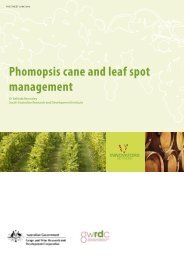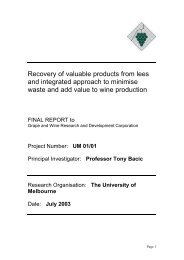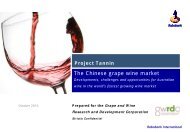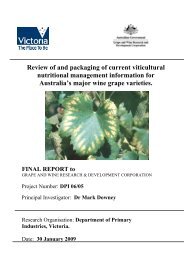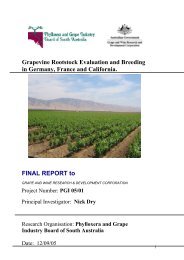Identification of the major drivers of 'phenolic' taste in ... - GWRDC
Identification of the major drivers of 'phenolic' taste in ... - GWRDC
Identification of the major drivers of 'phenolic' taste in ... - GWRDC
You also want an ePaper? Increase the reach of your titles
YUMPU automatically turns print PDFs into web optimized ePapers that Google loves.
AWRI: <strong>Identification</strong> Of The Major Drivers Of ‘Phenolic’ Taste In White W<strong>in</strong>es<br />
w<strong>in</strong>es. They also found that <strong>the</strong> concentrations <strong>of</strong> gallic and caffeic acid were correlated with <strong>the</strong><br />
perceived bitterness <strong>of</strong> <strong>the</strong>se w<strong>in</strong>es. However, such associations could be <strong>the</strong> result <strong>of</strong> co-correlation<br />
with o<strong>the</strong>r phenolic compounds.<br />
While <strong>the</strong> threshold estimates <strong>of</strong> <strong>the</strong> hydroxyc<strong>in</strong>namic acids and <strong>the</strong>ir tartaric acid esters differ greatly<br />
between studies summarised <strong>in</strong> Gawel (1998), <strong>the</strong>y are typically present <strong>in</strong> white w<strong>in</strong>e at<br />
concentrations near or below <strong>the</strong>ir detection threshold <strong>in</strong> water. This would <strong>in</strong>dicate that <strong>in</strong>dividually<br />
<strong>the</strong>y have little or no sensory impact on w<strong>in</strong>e. Us<strong>in</strong>g duo-trio difference test<strong>in</strong>g Vérette et al. (1988)<br />
reported that caffeic, coumaric and caftaric acids were undetectable <strong>in</strong> white w<strong>in</strong>e when present <strong>in</strong> <strong>the</strong><br />
upper range <strong>of</strong> white w<strong>in</strong>e concentrations. However, <strong>the</strong> effect <strong>of</strong> us<strong>in</strong>g a small number <strong>of</strong> <strong>taste</strong>rs<br />
comb<strong>in</strong>ed with apply<strong>in</strong>g a relatively <strong>in</strong>sensitive test method suggests this study should be revisited.<br />
Fur<strong>the</strong>rmore, even if <strong>the</strong> concentrations <strong>of</strong> <strong>in</strong>dividual phenolic species were <strong>in</strong>sufficient to <strong>in</strong>duce an<br />
astr<strong>in</strong>gent or bitter sensation <strong>in</strong> white w<strong>in</strong>e, <strong>the</strong>y may do so <strong>in</strong> comb<strong>in</strong>ation. The thresholds <strong>of</strong> mixtures<br />
<strong>of</strong> two or three hydroxyc<strong>in</strong>namic and hydroxybenzoic acids were <strong>in</strong> most cases found to be lower than<br />
<strong>the</strong> m<strong>in</strong>imum threshold <strong>of</strong> each <strong>of</strong> <strong>the</strong> components (Maga and Lorenz 1973). This result is not<br />
surpris<strong>in</strong>g as <strong>the</strong> <strong>in</strong>tensity <strong>of</strong> mixtures <strong>of</strong> similar tast<strong>in</strong>g bitter substances is generally additive (Keast et<br />
al. 2003). Therefore, although it appears that s<strong>in</strong>gle species <strong>of</strong> hydroxyc<strong>in</strong>namates and <strong>the</strong>ir<br />
derivatives are not bitter at <strong>the</strong> concentrations found <strong>in</strong> w<strong>in</strong>e, <strong>the</strong> possibility that <strong>the</strong> comb<strong>in</strong>ed impact<br />
<strong>of</strong> <strong>the</strong> entire hydroxyc<strong>in</strong>namate pool can elicit a perceptible bitterness <strong>in</strong> white w<strong>in</strong>e cannot be ruled<br />
out. Nagel et al. (1997) have suggested that hydroxyc<strong>in</strong>namates might not be bitter, expla<strong>in</strong><strong>in</strong>g that<br />
previous sensory assessors might have confused bitterness with <strong>the</strong> compounds’ sourness. They noted<br />
that after mask<strong>in</strong>g <strong>the</strong> acidity <strong>of</strong> a hydroxyc<strong>in</strong>namate with potassium bitartrate, <strong>taste</strong>rs were unable to<br />
discrim<strong>in</strong>ate bitterness <strong>in</strong> <strong>the</strong> sample. However, <strong>the</strong> possible mask<strong>in</strong>g role <strong>of</strong> <strong>the</strong> added salt on <strong>the</strong><br />
bitterness <strong>of</strong> <strong>the</strong> test sample was not considered.<br />
The oxidation product <strong>of</strong> caftaric acid, trans-2-S-glutathionyl caffeoyl tartaric acid (grape reaction<br />
product, or GRP) was also not perceptibly bitter when <strong>taste</strong>d at levels typically encountered <strong>in</strong> white<br />
w<strong>in</strong>e (Vérette et al. 1988). A study <strong>of</strong> six w<strong>in</strong>es produced from unoxidised juice and <strong>the</strong> correspond<strong>in</strong>g<br />
oxidised juice gave <strong>in</strong>conclusive results regard<strong>in</strong>g <strong>the</strong> role <strong>of</strong> GRP and bitterness (Nagel and Graber<br />
1988).<br />
1.2.2 Flavonols<br />
Quercet<strong>in</strong> glycones are <strong>the</strong> ma<strong>in</strong> flavonols <strong>in</strong> white w<strong>in</strong>e, although quantitative data <strong>in</strong> a representative<br />
range <strong>of</strong> Australian white w<strong>in</strong>es is not available <strong>in</strong> <strong>the</strong> published literature (McDonald et al. 1998;<br />
Boselli et al. 2006). The thresholds <strong>of</strong> flavonol aglycones are around 10-20 mg/L, determ<strong>in</strong>ed <strong>in</strong> 5%<br />
aqueous ethanol (Dadic and Belleau 1973), with descriptors such as ‘bitter’, ‘harsh’, and ‘astr<strong>in</strong>gent’.<br />
Therefore, it might be that flavonols and <strong>the</strong>ir glucosides are important ei<strong>the</strong>r <strong>in</strong>dividually or<br />
cumulatively, to <strong>the</strong> mouth-feel <strong>of</strong> white w<strong>in</strong>e.<br />
The impact <strong>of</strong> quercet<strong>in</strong> on white w<strong>in</strong>e astr<strong>in</strong>gency is unclear. Dadic and Belleau (1973) reported that<br />
it elicits a bitter <strong>taste</strong> with only a weak astr<strong>in</strong>gency when presented <strong>in</strong> water. However, rut<strong>in</strong> which is<br />
one common quercet<strong>in</strong> glycoside has recently been reported to elicit an astr<strong>in</strong>gent like sensation even<br />
at extremely low concentrations when found <strong>in</strong> black tea (Scharbert et al. 2004). The reason for <strong>the</strong>se<br />
conflict<strong>in</strong>g results is unclear. It might have been due to <strong>the</strong> two studies us<strong>in</strong>g free and glycosidically<br />
bound quercet<strong>in</strong>, as <strong>the</strong> astr<strong>in</strong>gency <strong>of</strong> quercet<strong>in</strong> glycosides appears to depend on <strong>the</strong> structure <strong>of</strong> <strong>the</strong><br />
Page | 15




